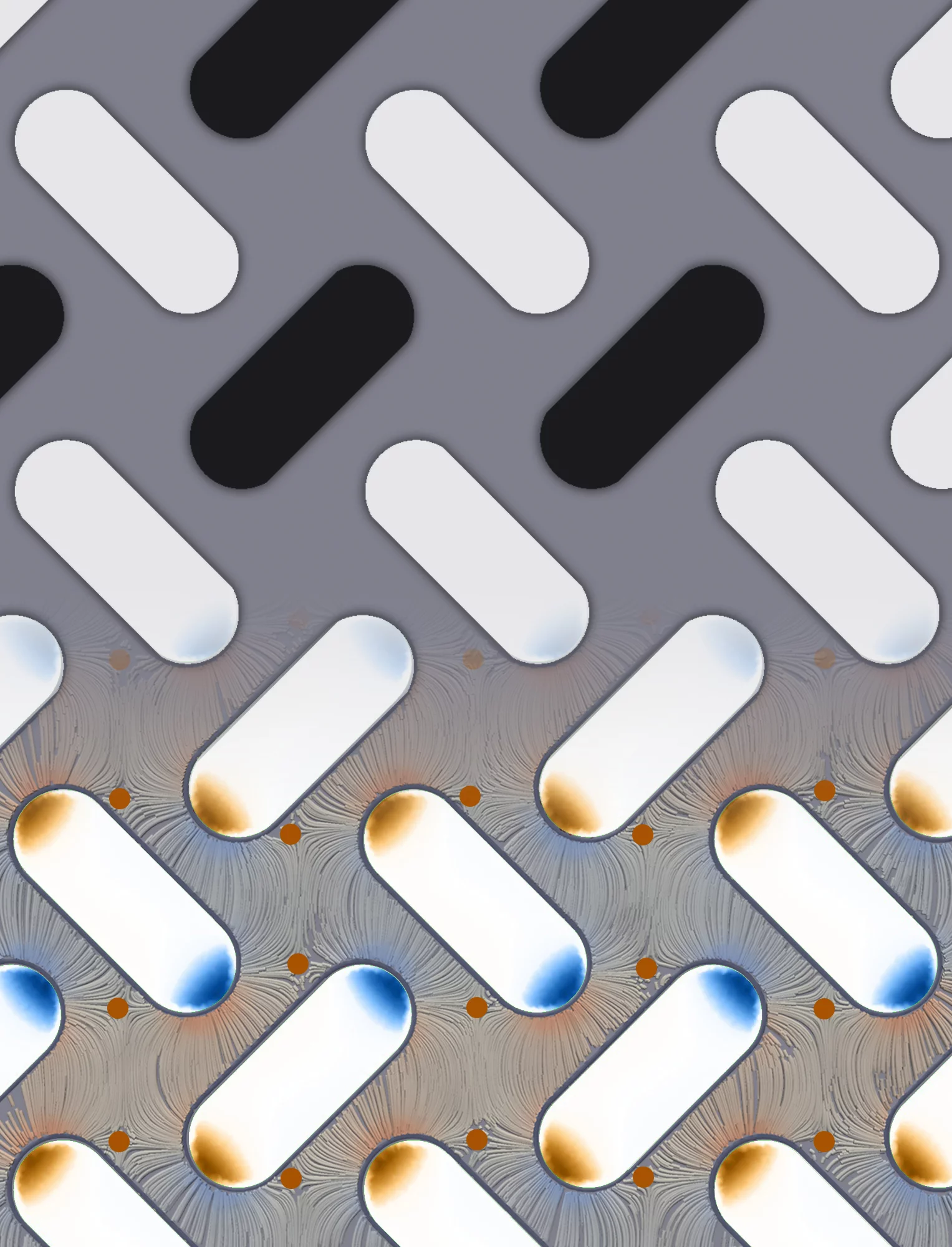The unexpected finding that in an ‘artificial spin ice’ magnetostatic energy can be transformed into directed rotation of magnetization provides fresh insights into such nano-patterned magnetic structures — and might enable novel applications in nanoscale devices.
Magnetism and rotation are intimately related. This connection can lead to surprising and non-intuitive effects, as first demonstrated a century ago, when it was predicted, and observed, that changing the magnetization in a piece of ferromagnetic material (such as iron) rotates it, ever so slightly; conversely, spinning a non-magnetised piece of the same material magnetizes it. These phenomena are known as Einstein—de Haas and Barnett effects, respectively, and are beautiful phenomena described in many physics textbooks. Now, Sebastian Gliga and colleagues in the Laboratory for Multiscale Materials Experiments at PSI, led by of Laura Heyderman, report in Nature Materials [1] the discovery of another sort of rotation in a magnetic structure, one that came as a surprise. They observed that after magnetising their sample, the magnetisation started to consistently rotate in one of two possible directions, without an obvious reason why one way should be preferred over the other.
Nano-tailored magnetic materials
Magnetism and rotation are intimately related. This connection can lead to surprising and non-intuitive effects, as first demonstrated a century ago, when it was predicted, and observed, that changing the magnetization in a piece of ferromagnetic material (such as iron) rotates it, ever so slightly; conversely, spinning a non-magnetised piece of the same material magnetizes it. These phenomena are known as Einstein—de Haas and Barnett effects, respectively, and are beautiful phenomena described in many physics textbooks. Now, Sebastian Gliga and colleagues in the Laboratory for Multiscale Materials Experiments at PSI, led by of Laura Heyderman, report in Nature Materials [1] the discovery of another sort of rotation in a magnetic structure, one that came as a surprise. They observed that after magnetising their sample, the magnetisation started to consistently rotate in one of two possible directions, without an obvious reason why one way should be preferred over the other.
Nano-tailored magnetic materials
The samples that the team studied, in an international collaboration, are anything but simple pieces of iron. They are two-dimensional structures consisting of tiny magnetic islands made of Permalloy, a nickel—iron alloy. The individual islands are merely 470 nm long and 170 nm wide, which means that in each of these nanomagnets only one single magnetic domain exists; that is, the magnetisation can only point in one of two directions along the long axis of the magnet. Such nanostructures can be produced lithographically with great precision, and the PSI group had demonstrated in the past that these systems are an ideal testing ground for exploring intriguing physics, including that of so-called spin-ice phases, in which the geometry of the array prevents the formation of conventional magnetic patterns but gives rise to so-called geometric frustration.
In such artificial spin-ice structures, Gliga and co-workers have now observed that when the total magnetisation (that of all nanomagnets taken together) is initially set by an external field to point in one direction, it then starts to rotate clockwise once that field is removed. The rotation stops at some point, but when the spin ice is heated up, the magnetisation continues to rotate in the same direction, until it has rotated by 180°.
One-way ticket
In such artificial spin-ice structures, Gliga and co-workers have now observed that when the total magnetisation (that of all nanomagnets taken together) is initially set by an external field to point in one direction, it then starts to rotate clockwise once that field is removed. The rotation stops at some point, but when the spin ice is heated up, the magnetisation continues to rotate in the same direction, until it has rotated by 180°.
One-way ticket
But why does the magnetisation in these experiments turn always clockwise and never counter-clockwise? Adding to the puzzle, the effect appeared only when the overall array was sufficiently large. That suggested that the asymmetric pattern formed by the islands was not responsible in itself for the one-way preference. Combining soft x-ray photoemission electron microscopy and numerical modelling, the researchers found that instead the magnetostatic energy landscape of the entire array changes dynamically once the initial external field is switched off. In particular, the stray field at the array edges generates an asymmetry in an intricate, but reproducible manner. In other words, the overall behaviour cannot be explained from looking at the individual components of the array, but emerges from their collective behaviour and in particular from the behaviour at the edges. Intriguingly, the precise shape of the edge does not matter, suggesting that the observed effect is robust against imperfections. And there are ways to steer what is happening to the magnetisation: in some of the cases studied by Gliga et al. the sense of rotation of the magnetisation could be reversed by applying additional external magnetic fields.
A practical spin on a fundamental finding
Taken together, these findings establish an unexpected route to transform magnetostatic energy (provided by the initial magnetic field) into directed motion of magnetization. And whereas the significance of Einstein–de Haas and Barnett effects remain largely confined to the realm of textbooks, the effect now found in the two-dimensional magnetic structures comes with the promise to be of practical use in nanoscale devices, including magnetic nanomotors, actuators, sensors and data storage.
This work was carried out in a collaboration led by Sebastian Gliga (Marie Curie Research Fellow at the University of Glasgow, UK, and visiting scientist at PSI) and Laura Heyderman (PSI and ETH Zurich), involving Robert Stamps of the University of Glasgow, now at the University of Manitoba, Canada (theory) and Gino Hrkac of the University of Exeter, UK (numerical modelling). Soft x-ray photoemission electron microscopy was carried out at the SIM beamline of the Swiss Light Source at PSI and at the Advanced Light Source, Berkeley National Laboratory, US.
A practical spin on a fundamental finding
Taken together, these findings establish an unexpected route to transform magnetostatic energy (provided by the initial magnetic field) into directed motion of magnetization. And whereas the significance of Einstein–de Haas and Barnett effects remain largely confined to the realm of textbooks, the effect now found in the two-dimensional magnetic structures comes with the promise to be of practical use in nanoscale devices, including magnetic nanomotors, actuators, sensors and data storage.
This work was carried out in a collaboration led by Sebastian Gliga (Marie Curie Research Fellow at the University of Glasgow, UK, and visiting scientist at PSI) and Laura Heyderman (PSI and ETH Zurich), involving Robert Stamps of the University of Glasgow, now at the University of Manitoba, Canada (theory) and Gino Hrkac of the University of Exeter, UK (numerical modelling). Soft x-ray photoemission electron microscopy was carried out at the SIM beamline of the Swiss Light Source at PSI and at the Advanced Light Source, Berkeley National Laboratory, US.
Contact
Dr. Sebastian GligaPaul Scherrer Institut, 5232 Villigen PSI, Switzerland
Phone: +41 56 310 2056, e-mail: sebastian.gliga@psi.ch
Original Publication
1. Emergent dynamic chirality in a thermally driven artificial spin ratchetGliga S, Hrkac G, Donnelly C, Büchi J, Kleibert A, Cui J, Farhan A, Kirk E, Chopdekar RV, Masaki Y, Bingham NS, Scholl A, Stamps RL and Heyderman LJ
Nature Materials, DOI: 10.1038/nmat5007 (2017).
Additional reading
Artificial spin ice: A ratchet made of tiny magnets (News & Views article)Bramwell ST
Nature Materials, DOI: 10.1038/nmat5004 (2017).




